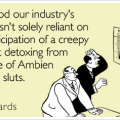
For the past few days, people that don’t even play golf – that don’t even know how to hold a club – are coming up to me and saying things like, “Hey, it’s Masters week…aren’t you excited?” This is proof The Masters has transcended sports – it’s the closest thing golf has to the Super Bowl or Final Four, where even non-sports fans are vaguely aware of its existence.
But as the saying goes: “With great power comes great responsibility.” And I’m not so sure this tournament is putting golf’s best foot forward. While there’s good in The Masters, there’s also a dark side.
For starters, The Masters is, in fact, the best marketing tool the industry has to kick-off the golf season. Think about it: Just as the ground is thawing in the northern part of the world, here comes the most popular tournament of the year to help get the proverbial golf juices flowing.
In addition, the event is held at one of the most beautiful golf clubs in the world – Augusta National. When the tournament is held in early April, Georgia is already in the full bloom of spring – with magnolias and azaleas adding magnificent highlights to a lush, emerald-green grass backdrop (and if spring is late, they’ll just get the spray paint out…).
Of course, Augusta National is also the poster child for every single negative golf stereotype…like, ever. It didn’t allow African Americans until the 1990’s. It didn’t allow women until 2012 (and when finally doing so, it pulled off what can be called one of the biggest public relations stunts in golf by naming Condoleeza Rice as a member…who is both black and a woman).
And if having a membership of predominately white men doesn’t personify the golf stereotype enough, the invitation-only club features names that reek of money…Bill Gates and Warren Buffett to name just two. So the equation would look something like this: White + Rich + Men = Augusta. And if Augusta = Golf (as many would agree), then Golf = White + Rich + Men.
Thus, The Masters is a catch-22 for the golf industry. On the one hand, it’s the kick-start the game desperately needs at the beginning of each season. Yet on the other hand, the legendary course has a history in stark contrast to how the golf industry wants to grow – in particular to minorities and women.
Yet The Masters influences golfers all over the world. After all, Augusta National is easy on the eyes and beautiflul in both appearance and layout. Mere images of Amen Corner fill your head with blissful daydreams – of navigating those cushy fairways – every step so magical you’re truly concerned that soft spikes aren’t soft enough.
Oh what we golfers wouldn’t give to experience this oasis of a course that offers such contrast to our local munis. Why can’t your club look like this? Well, it can – you just wouldn’t be able to afford it anymore.
This is a cruel coincidence of The Masters – the notion that all of which inspires us each spring is very rarely (if ever) accessable to the average golfer. In fact, Augusta National has set such high grooming standards for itself that it must resort to camouflaging its blemishes just to maintain appearances.
All this has led to the “Augusta Effect” – the notion that golfers have come to expect impossibly high standards of their local course from what they see on their HDTV each spring. This, in turn, has ultimately led to higher greens fees throughout the game.
While still struggling to overcome recent economic woes, golfers and the golf industry alike are left trying to live up to expectations they can no longer afford. A catch-22 indeed. There’s a gigantic rift between what made golf what it is today and where it needs to go for tomorrow.
Despite this however, The Masters has ultimately bled into the American mainstream. It, for better or worse, has helped put golf on the map for the general public. For this, it will forever be synonymous with both the start of the golf season and the beauty this game has to offer.
It’s just too bad the host course has such an unsavory past.




The club and the tournament have indeed strayed far from Bob Jones’ original concepts. I blame Cliff Roberts.
This is an interesting article. It’s true that the Masters and Augusta often have differing views in terms of their history and the image they want to portray.
Personally, I think that things can change, and Augusta can improve its image of this predominantly white, rich and male culture that it has currently.